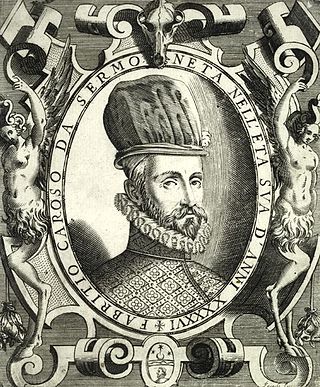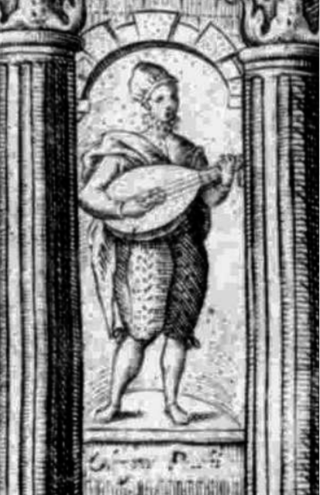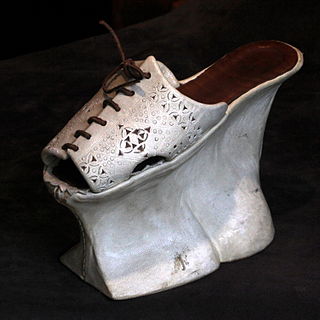
The galliard ( /ˈɡæljərd/ ; French : gaillarde; Italian : gagliarda) was a form of Renaissance dance and music popular all over Europe in the 16th century. It is mentioned in dance manuals from England, Portugal, France, Spain, Germany, and Italy.

The galliard ( /ˈɡæljərd/ ; French : gaillarde; Italian : gagliarda) was a form of Renaissance dance and music popular all over Europe in the 16th century. It is mentioned in dance manuals from England, Portugal, France, Spain, Germany, and Italy.
The galliard is not an improvised dance, but rather, it consists of choreographed patterns of steps, which occupy one or more measures of music. In one measure, a galliard typically has five steps; in French such a basic step is called a cinq pas and in Italy, cinque passi. This is sometimes written in English sources as sinkapace. These steps are: right, left, right, left, cadence.
The galliard is an athletic dance, characterised by leaps, jumps, hops and other similar figures. The main feature that defines a galliard step is a large jump, after which the dancer lands with one leg ahead of the other. This jump is called a cadence, and the final landing is called the posture. The cadence is typically preceded by three quick hops with alternating feet. [1] The sources generally describe movement patterns starting on the left foot, then repeating it starting with the right foot. A galliard pattern may also last twice as long, or more, which would involve 11 steps, or 17 steps.

The galliard was a favourite dance of Queen Elizabeth I of England, and although it is a relatively vigorous dance, in 1589 when the Queen was aged in her mid-fifties, John Stanhope of the Privy Chamber reported, "the Queen is so well as I assure you, six or seven galliards in a morning, besides music and singing, is her ordinary exercise." [2]
While most commonly being an entire dance, the galliard's steps are used within many other forms of dance. For example, 16th-century Italian dances in Fabritio Caroso's (1581) and Cesare Negri's (1602) dance manuals often have a galliard section.
One special step used during a galliard is lavolta, a step which involves an intimate, close hold between a couple, with the woman being lifted into the air and the couple turning 270 degrees, within one six-beat measure. Lavolta was considered by some dancing masters as an inappropriate dance.
Another special step used during a galliard is the tassel kick ("salto del fiocco"). These steps are found in Negri's manual and involve a galliard step usually (though not always) ending with a spin. The easier steps involve single spins of 180 or 360 degrees; later, more difficult steps involve multiple sequential spins and spins of up to at least 540 degrees. During the spin, the dancer kicks out to touch a tassel suspended between knee and waist height.

Musical compositions in the galliard form appear to have been written and performed after the dance fell out of popular use. In musical compositions, the galliard often filled the role of an after dance written in 6, which followed and mimicked another piece (sometimes a pavane) written in 4. The distinctive 6 beats to the phrase can still be heard today in songs such as "God Save the King".

Fabritio Caroso da Sermoneta was an Italian Renaissance dancing master and a composer or transcriber of dance music.

The pavane is a slow processional dance common in Europe during the 16th century (Renaissance).

Renaissance dances belong to the broad group of historical dances, specifically those during the Renaissance period. During that period, there was a distinction between country dances and court dances. Court dances required the dancers to be trained and were often for display and entertainment, whereas country dances could be attempted by anyone. At Court, the formal entertainment would often be followed by many hours of country dances which all present could join in. Dances described as country dances such as Chiarantana or Chiaranzana remained popular over a long period – over two centuries in the case of this dance. A Renaissance dance can be likened to a ball.

In music, metre or meter refers to regularly recurring patterns and accents such as bars and beats. Unlike rhythm, metric onsets are not necessarily sounded, but are nevertheless implied by the performer and expected by the listener.
Dance moves or dance steps are usually isolated, defined, and organized so that beginning dancers can learn and use them independently of each other. However, more complex movements are influenced by musicality and lyrical relevance to express emotions or refer to a message. Dance moves tend to emphasize the concepts of lead and follow and connection.

The volta is an anglicised name for a dance for couples that was popular during the later Renaissance period. This dance was associated with the galliard and done to the same kind of music. Its main figure consisted of a turn and lift in a sort of closed position, which could be done either to the right or to the left. It is also called La volta, Volta, Volte. Spelling variants include la volta and levolto; its name is la volte in French and la volta in Italian. It was considered at first to be risque and controversial. Although the dance was known at the court of Elizabeth I, the popular notion that Elizabeth and her favourite Lord Robert Dudley regularly performed the volta has been repudiated.
In Western musical theory, a cadence is the end of a phrase in which the melody or harmony creates a sense of full or partial resolution, especially in music of the 16th century onwards. A harmonic cadence is a progression of two or more chords that concludes a phrase, section, or piece of music. A rhythmic cadence is a characteristic rhythmic pattern that indicates the end of a phrase. A cadence can be labeled "weak" or "strong" depending on the impression of finality it gives.

Historical dance is a term covering a wide variety of Western European-based dance types from the past as they are danced in the present. Today historical dances are danced as performance, for pleasure at themed balls or dance clubs, as historical reenactment, or for musicological or historical research.

The cha-cha-cha is a dance of Cuban origin. It is danced to cha-cha-cha music introduced by the Cuban composer and violinist Enrique Jorrin in the early 1950s. This rhythm was developed from the danzón-mambo. The name of the dance is an onomatopoeia derived from the shuffling sound of the dancers' feet when they dance two consecutive quick steps that characterize the dance.

The basse danse, or "low dance", was a popular court dance in the 15th and early 16th centuries, especially at the Burgundian court. The word basse describes the nature of the dance, in which partners move quietly and gracefully in a slow gliding or walking motion without leaving the floor, while in livelier dances both feet left the floor in jumps or leaps. The basse danse was a precursor of the pavane as a dignified processional dance. The term may apply to the dance or the music alone.
Shakespearean dance refers to dancing in the time and plays of William Shakespeare and his contemporaries.

Giovanni Picchi was an Italian composer, organist, lutenist, and harpsichordist of the early Baroque era. He was a late follower of the Venetian School, and was influential in the development and differentiation of instrumental forms which were just beginning to appear, such as the sonata and the ensemble canzona; in addition he was the only Venetian of his time to write dance music for harpsichord.

A branle, also bransle, brangle, brawl(e), brall(e), braul(e), brando, bran, or brantle, is a type of French dance popular from the early 16th century to the present, danced by couples in either a line or a circle. The term also refers to the music and the characteristic step of the dance.

A chopine is a type of women's platform shoe that was popular in the 15th, 16th and 17th centuries. Chopines were originally used as a patten, clog, or overshoe to protect shoes and dresses from mud and street soil.

Cesare Negri was an Italian dancer and choreographer. He was nicknamed il Trombone, an ugly or jocular name for someone "who likes to blow his own horn". Born in Milan, he founded a dance academy there in 1554. He was an active court choreographer for the nobility in Milan. He wrote Le Grazie d'Amore, the first text on ballet theory to expound the principle of the five basic positions. It was republished in 1604 as Nuove Inventioni di Balli.
Dajchovo horo is a Bulgarian folk dance done to a nine-beat meter. It is unique in two ways: it is a circle dance, and yet it has a leader.
The Dublin Virginal Manuscript is an important anthology of keyboard music kept in the library of Trinity College Dublin, where it has been since the 17th century under the present shelf-list TCD Ms D.3.29.

Italian folk dance has been an integral part of Italian culture for centuries. Dance has been a continuous thread in Italian life from Dante through the Renaissance, the advent of the tarantella in Southern Italy, and the modern revivals of folk music and dance.

Italian ballet is the training methods and aesthetic qualities seen in classical ballet in Italy. Ballet has a long history in Italy, and it is widely believed that the earliest predecessor of modern-day ballet originated in the Italian courts of the Renaissance. Two predominant training systems are used to teach Italian ballet today: the Cecchetti method, devised by Enrico Cecchetti, and that of the La Scala Theatre Ballet School.
The Canary dance was a Renaissance dance inspired in an indigenous dance and song of the Canary Islands, Spain that became popular all over Europe in the late 16th and early 17th century. It is mentioned in dance manuals from France and Italy, and is mentioned in sources from Spain and England, as well, including in plays by William Shakespeare.